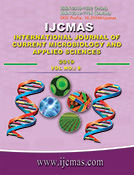


 National Academy of Agricultural Sciences (NAAS)
National Academy of Agricultural Sciences (NAAS)

|
PRINT ISSN : 2319-7692
Online ISSN : 2319-7706 Issues : 12 per year Publisher : Excellent Publishers Email : editorijcmas@gmail.com / submit@ijcmas.com Editor-in-chief: Dr.M.Prakash Index Copernicus ICV 2018: 95.39 NAAS RATING 2020: 5.38 |
This study was conducted on the alluvial plain of Karfiguela in the extreme southwest part of Burkina Faso as part of the Support Program for Irrigation Development (PADI). The main objectives of this study are: (1) the identification and delineation of the alluvial plain (2) identification and characterization of the geological nature of the of the lithology of the plain (3) identification and characterization of the average power of the plain and (4) the determination of the hydrodynamic properties and directions and flow direction of groundwater in the alluvial plain of Karfiguela. Concerning the characterization of materials, two investigative techniques were used for this study: (i) the electrical resistivity tomography (ERT), and (ii) the auger surveys (micro-drilling). The first technique allowed us to obtain resistivity distribution and to deduct from the nature of geological formations in place as well as their thicknesses. The second technique leads to a direct observation of the tabulations and the granulometry of the different layers that constitute the plain on a given depth. All methods lead to the same results overall, with the only difference that the second is much more accurate compared to the stratigraphy, and to the real nature of the geological layers. The results of these studies will enable to identify areas where accessibility to shallow aquifers is readily available to mobilize groundwater resources to carry out dry season cropping.
 |
 |
 |
 |
 |